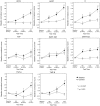Dose-related effects of alcohol on cognitive functioning
- PMID: 23209840
- PMCID: PMC3510176
- DOI: 10.1371/journal.pone.0050977
Dose-related effects of alcohol on cognitive functioning
Abstract
We assessed the suitability of six applied tests of cognitive functioning to provide a single marker for dose-related alcohol intoxication. Numerous studies have demonstrated that alcohol has a deleterious effect on specific areas of cognitive processing but few have compared the effects of alcohol across a wide range of different cognitive processes. Adult participants (N = 56, 32 males, 24 females aged 18-45 years) were randomized to control or alcohol treatments within a mixed design experiment involving multiple-dosages at approximately one hour intervals (attained mean blood alcohol concentrations (BACs) of 0.00, 0.048, 0.082 and 0.10%), employing a battery of six psychometric tests; the Useful Field of View test (UFOV; processing speed together with directed attention); the Self-Ordered Pointing Task (SOPT; working memory); Inspection Time (IT; speed of processing independent from motor responding); the Traveling Salesperson Problem (TSP; strategic optimization); the Sustained Attention to Response Task (SART; vigilance, response inhibition and psychomotor function); and the Trail-Making Test (TMT; cognitive flexibility and psychomotor function). Results demonstrated that impairment is not uniform across different domains of cognitive processing and that both the size of the alcohol effect and the magnitude of effect change across different dose levels are quantitatively different for different cognitive processes. Only IT met the criteria for a marker for wide-spread application: reliable dose-related decline in a basic process as a function of rising BAC level and easy to use non-invasive task properties.
Conflict of interest statement
Figures


References
-
- Fillmore MT (2007) Acute alcohol-induced impairment of cognitive functions: Past and present findings. International Journal on Disability and Human Development 6: 115–125.
-
- Finnigan F, Hammersley R (1992) The effects of alcohol on performance. In: Smith AP, Jones DM, editors. Handbook of human performance. London: Academic Press. 73–126.
-
- Koelega HS (1995) Alcohol and vigilance performance: review. Psychopharmacology 118: 233–249. - PubMed
-
- Matthews DB, Silvers JR (2004) The use of acute ethanol administration as a tool to investigate multiple memory systems. Neurobiology of Learning and Memory 82: 299–308. - PubMed
Publication types
MeSH terms
Substances
LinkOut - more resources
Full Text Sources
Miscellaneous

